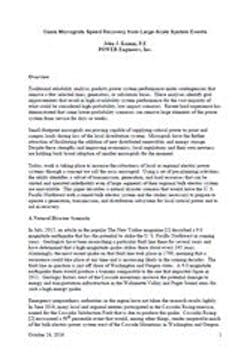In addition to preparing the utility response to a Large-Scale System Events, the planning and preparation activities have these additional immediate benefits to the utility and its customers:
• Preparing and documenting the system inventory offers improved awareness of the system assets and their condition.
• Oasis system performance studies improve understanding of the system operation in lower-impact, higher probability system events that leave greater portions of the system in service.
• Generation, communication and control backups and redundancies make these systems, the utility, and its staff performance more robust.
• Identification and installation of black start capabilities, along with documentation of their use, increases the availability of local generation in lower-impact events.
• The ability of the utility to provide synching voltage to privately-owned DER in a catastrophic event may encourage the investment in DER by utility customers, encouraging the penetration and effectiveness of renewables and energy storage.
Oasis microgrid planning helps speed utility response and recovery to disaster scenarios of several sorts. These activities improve local resiliency and encourage use of DER. As traditional microgrid economics and regulations become more favorable, oasis microgrid planning may offer one more reason for private owners to install them. Finally, these preparations serve to create a more flexible electric grid that can operate more reliably at nearly any available scale.
Traditional reliability analysis predicts power system performance under contingencies that remove a few selected lines, generators, or substation buses. These analyses identify grid improvements that result in high-availability system performance for the vast majority of what could be considered high-probability, low impact scenarios. Recent hard experience has demonstrated that some lower-probability scenarios can remove large elements of the power system from service for days or weeks.
Small-footprint microgrids are proving capable of supplying critical power to point and campus loads during loss of the local distribution system. Microgrids have the further attraction of facilitating the addition of new distributed renewables and energy storage. Despite these strengths and improving economics, local regulations and their own newness are holding back broad adoption of smaller microgrids for the moment.
Today, work is taking place to increase the robustness of local or regional electric power systems through a concept we call the oasis microgrid. Using a set of pre-planning activities, the utility identifies a subset of transmission, generation, and load resources that can be started and operated indefinitely even if large segments of their regional bulk electric system are unavailable. This paper describes a natural disaster scenario that would leave the U. S. Pacific Northwest with a ruined bulk electric system and the studies necessary to prepare to operate a generation, transmission, and distribution subsystem for local critical power and to aid in recovery.
